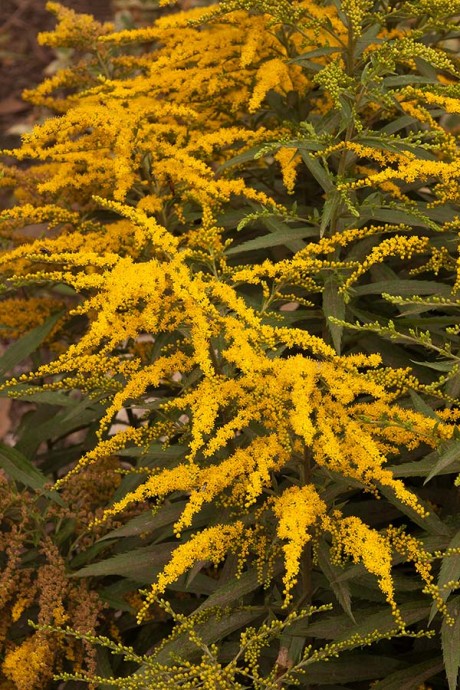Goldenrod in the garden
Plus garden to-do's for August and September
By L.A. JacksonEven in the lessening light of the late summer sun, there is still a bright botanical show to be seen, as one of the flashiest plants of the waning growing season has begun shining its brilliant yellow glow across fields, meadows, landscapes and gardens. Unfortunately, it also happens to be a very misunderstood plant — goldenrod (Solidago sp.).
Mention goldenrod and many sufferers of hay fever will brace themselves to get ready for a big “A-A-A-CHOO-O-O!” because the pollen from its flowers will make you sneeze, right? Wrong. Examine the pollen on a cluster of goldenrod blossoms, and you will find that it is not light enough to become wind-borne and drift up the snoot.
What’s really happening is the inconspicuous blooms of ragweed flowering at the same time as goldenrod. Ragweed has minute pollen that can easily fly away in the slightest breeze. So the real culprit is ragweed, but the showy clusters of goldenrod usually get the blame.
Although mainly native to North America, goldenrod has been embraced by British gardeners for over 250 years. Now though, goldenrod is finding its pretty way into cultivated American gardens as well, and why not? The bright blooms are long-lasting, and these tough-as-nails plants require very little maintenance.
A hardy perennial, goldenrod can be planted anytime, but late summer and early fall are ideal times. For the best blooms, place the plants in an area that receives as much full sun as possible. Depending on the species (and there are about 150), goldenrods can stretch from 1 to 5 feet tall. Pinching back the tips in late spring will promote bushier growth and a fuller display of flowers.
An obvious planting scheme is to mix goldenrod with other plants that also bloom late in the growing season. Need examples? Try bouncing the handsome yellow flowers off the pretty purples of ironweed (Vernonia noveboracensis), Mexican bush sage, (Salvia leucantha) or New England aster (Symphyotrichum novae-angliae).
Garden To-Do's for August and September
August
- Fall-fruiting ornamentals such as holly, pyracantha and nandina should be well mulched and watered regularly during extended periods of hot, dry weather to prevent them from shedding their berries before they mature.
- If the summer vegetable garden is starting to poop out, try new plantings early this month of cucumbers, eggplant, peppers, squash and tomatoes for a fall flurry of fresh produce.
- And now is a good time to prepare for the autumn veggie garden. Cool-season edibles such as spinach, broccoli, cauliflower, collards and lettuce can be started in seed trays in a shady location.
- Ever-blooming and fall-blooming roses should be lightly fertilized now to perk them up for their flashy autumn displays.
- Even in the heat of the late summer, bird activity remains high, so keep the bird feeder filled and top off the bird bath with fresh water at least once a week.
September
- Indoor plants that have vacationed out on the porch or patio this summer should be returned inside before nighttime temperatures dip into the 50s.
- Falling leaves will soon provide plenty of fuel for the organic cooking of a compost pile, so find and clear a good location for this soil-conditioning garden helper.
- Landscape to conserve energy? You bet, especially if you plant evergreen trees and shrubs on the northern and northwestern sides of your house to help block the heat-robbing effects of coldest winter winds, which usually blow in from the north.
- Curb your fetish to fertilize outdoor garden plants with high-nitrogen products. Now is not the time to encourage tender, new growth on perennials and woody ornamentals because the plants need to “toughen up” while they are preparing for the coming winter.
- Perennial herbs such as mints, parsley, chives and lemon balm can now be divided. And think about fixing up a few pots of these helpful herbs for an indoor kitchen garden this winter.
-
Share this story:



